Elbow pain can be caused by overuse, repetitive motion, injury, or underlying conditions like arthritis or nerve compression. Whether it’s a dull ache during activity, sharp pain when lifting, or numbness and tingling down the arm, elbow pain can impact your ability to work, exercise, or enjoy daily life. Ortho Bethesda specializes in diagnosing the cause of elbow pain and providing personalized treatment options—from physical therapy and injections to minimally invasive procedures—to help you find lasting relief and restore mobility.
Meet Our Doctors Who Treat the Elbow
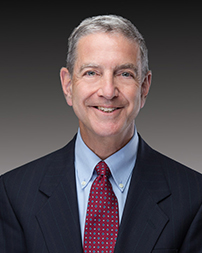
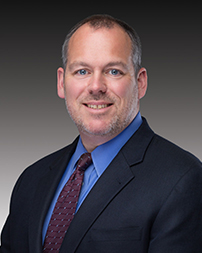
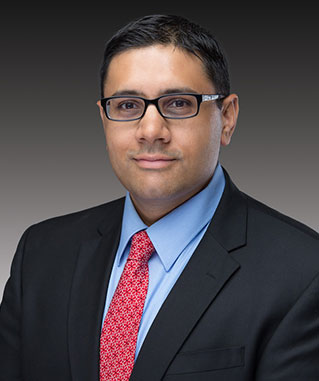
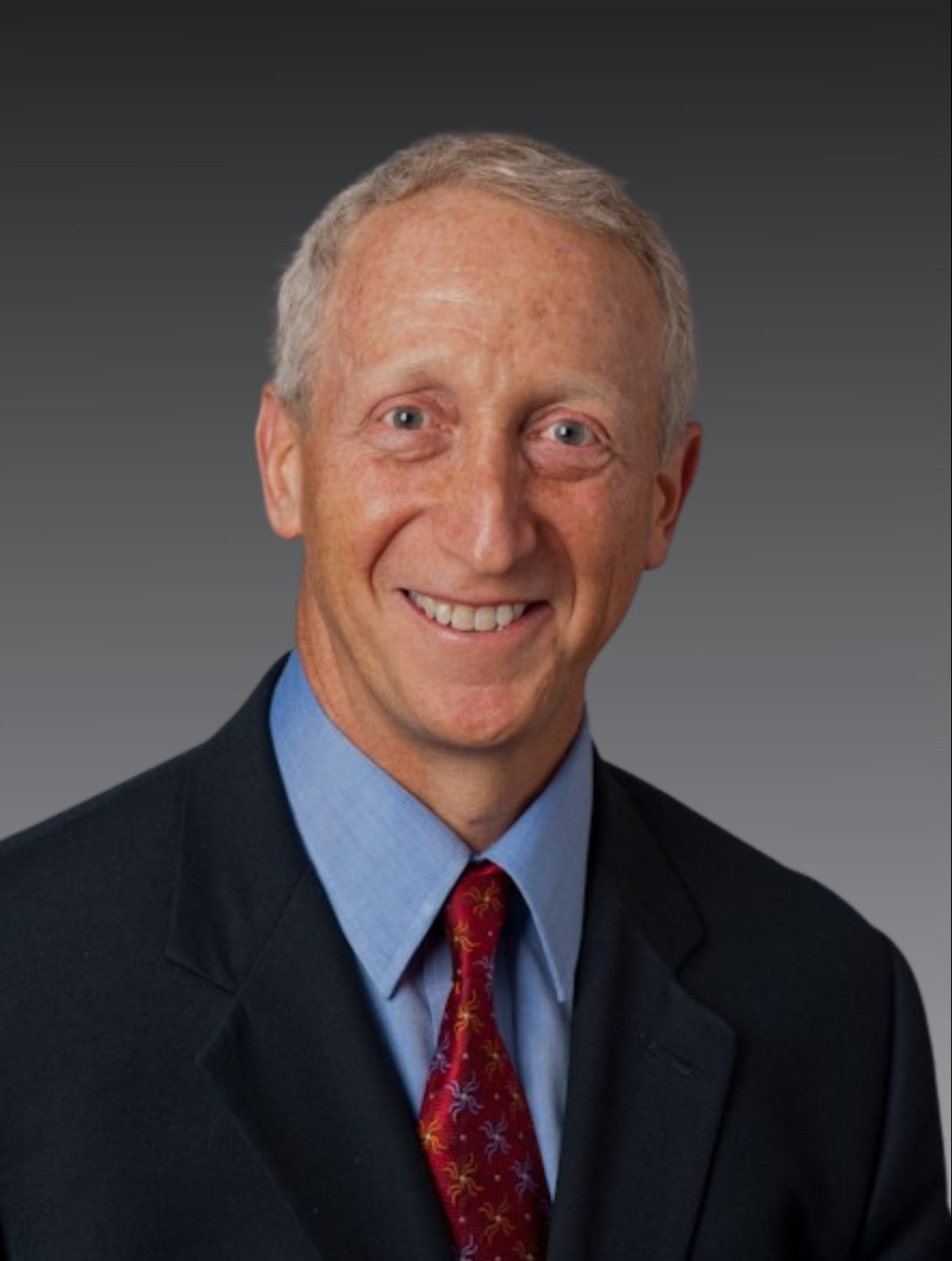
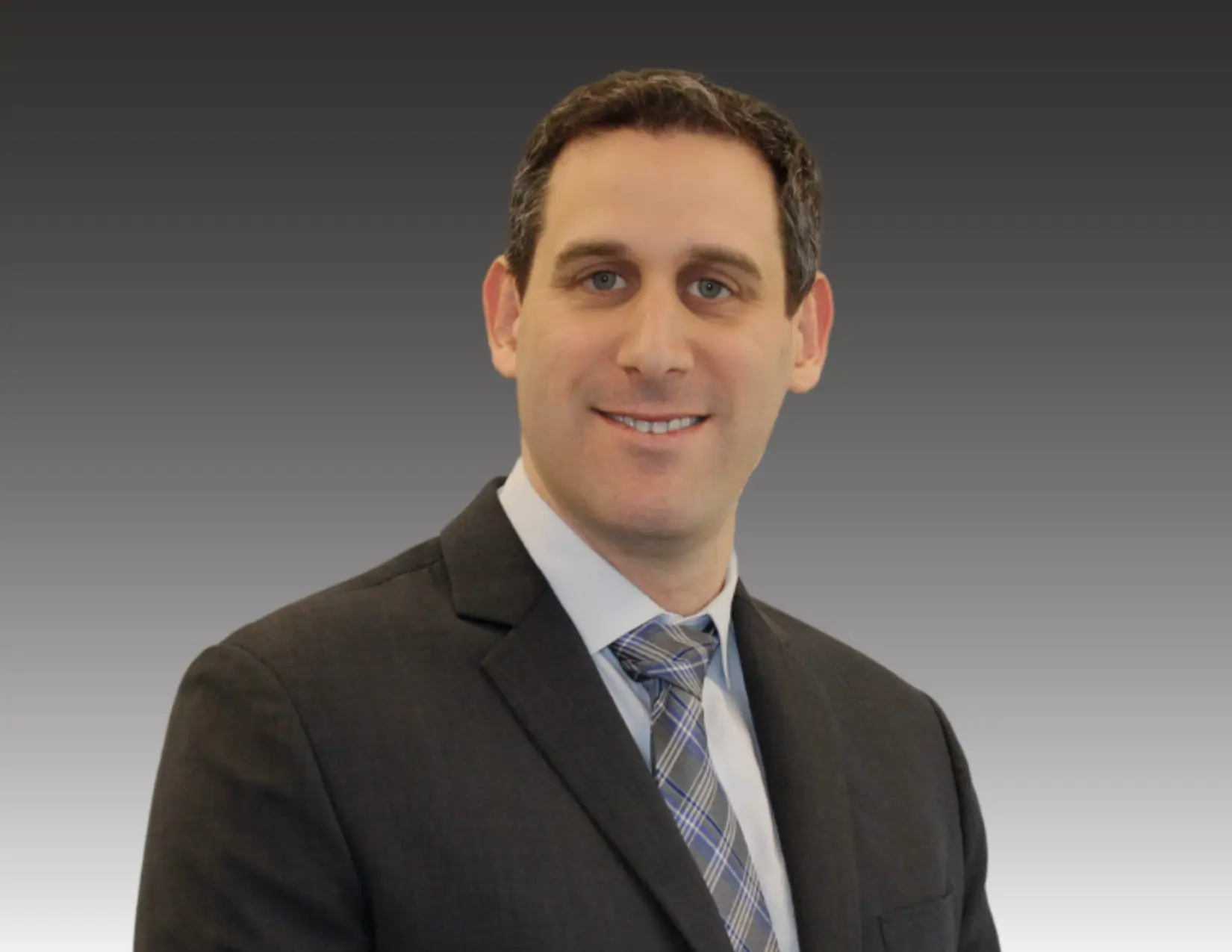
Elbow Conditions and Treatments
The elbow is a hinge joint consisting of three bones. The upper part of the hinge is at the end of the upper arm bone (humerus), and the lower part of the hinge is at the top of the two forearm bones (radius and ulna) which are side by side. When the elbow is bent, the ends of the two forearm bones rub against the end of the humerus.
Conditions:
Treatments:
Your Elbow Surgery
The elbow is a hinge joint consisting of three bones whose function is to help us position our hand in space. When we flex our elbow it brings our hand towards our mouth and when it extends our hand moves away from our mouth. The upper part of the hinge is at the end of the upper arm bone (humerus), and the lower part of the hinge is at the top of the two forearm bones (radius and ulna) which are side by side. When the elbow is bent, the ends of the two forearm bones rub against the end of the humerus.
Bones of Elbow Joint
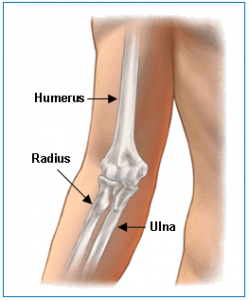
There are three bones of the elbow. One is the humerus, or the upper arm bone. The other two bones make up the forearm. The ulna is the bone that is more towards our body when we have our arms at our side and the palms facing forward. It is attached to the side of the hand with the small finger on it. Finally, there is the radius which is the bone that is away from our body when we have our arms at our side and palms facing forward. It attaches to the side of our hand where the thumb is. This bone rotates around the ulna which allows us to turn our palms up or palms down.
In a healthy elbow joint, the surfaces of these bones are very smooth and covered with a tough protective tissue called cartilage. Arthritis causes damage to the bone surfaces and cartilage where the three bones rub together. These damaged surfaces eventually become painful.
Elbow Ligaments
Although the bones of the elbow joint interlock tightly they require the assistance of ligaments to hold them together. Ligaments are soft tissue structures that attach bones to bones, typically helping to stabilize a joint. There are two main ligaments of the elbow. The medial, or ulnar collateral ligament attaches to the bump, known as an epicondyle, on the medial, or inner part of our elbow that is close to our body and inserts on the upper part of the ulna. The lateral, or radial collateral ligament attaches to the bump on the lateral, or outer part of our elbow that is away from our body and inserts on the upper radius and ulna. These ligaments help to prevent our elbow from hinging side to side and can be injured in a fall. The ulnar collateral ligament can also be stretched over time from repetitive throwing such as occurs in baseball pitchers.
Elbow Tendons
Tendons attach muscles to bone and allow our muscles to move our joints. There are two major tendons around our elbow. The biceps tendon is in the front of the elbow. You can feel this cord like structure if you place one hand on the front of your opposite elbow and then flex, or bend this elbow while keeping your palm up. The triceps tendon is on the back of the elbow and extends, or straightens the elbow.
Elbow Muscles
The major muscles around the elbow include the biceps and triceps. The biceps is on the front of the upper arm and not only flexes, or bends the elbow but also helps to turn our palms up. The triceps is located on the back of the elbow and extends or straightens our arms. Most of the muscles that flex our fingers and wrist when we make a fist insert on the inner bump, or medial epicondyle, of the elbow. The muscles that straighten the fingers and wrist insert on the outer bump, or lateral epicondyle.
Elbow Nerves
The nerves around the elbow are very close to the skin. The ulna nerve is behind the medial epicondyle and we are aware of it when we hit our “funny-bone”. The median nerve is in front of the elbow and the radial nerve is on the back, or posterior and lateral aspect of the elbow.
Elbow Blood Vessels
The major blood vessel around the elbow is the brachial artery. It is located on the front of the elbow. It then splits and becomes the radial and ulna arteries to our hand.
Arthritic Elbow Joint Surfaces
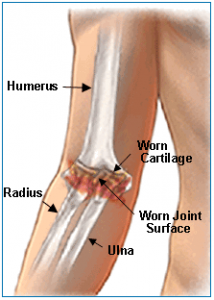
There are many ways to treat the pain caused by arthritis. One way is total elbow replacement surgery. The decision to have total elbow replacement surgery should be made very carefully after consulting your doctor and learning as much as you can about the elbow joint, arthritis, and the surgery.
In total elbow replacement surgery, an artificial hinge made of metal and a very durable plastic material is inserted into the joint so that the elbow can move without allowing the two forearm bones to contact the humerus. We call this artificial hinge an “implant.”
Getting to the Joint
The patient is first taken into the operating room and given anesthesia. After the anesthesia has taken effect, the skin around the elbow is thoroughly scrubbed and sterilized with an antiseptic liquid. A tourniquet is then applied to the upper portion of the arm to help slow the flow of blood.
An incision about six inches long is then made over the elbow joint. The incision is gradually made deeper through muscle and other tissue until the bones of the elbow joint are exposed.
Preparing the Bones
One of the forearm bones, the ulna, has a projection at the end, which extends up and behind the end of the humerus. A special power saw is used to remove part of this projection
A second purpose of the preoperative therapy visit is to prepare you for your upcoming surgery. You will begin to practice some of the exercises you will use just after surgery. You will also be trained in the use of either a walker or crutches. Whether the surgeon uses a cemented or noncemented approach may determine how much weight you will be able to apply through your foot while walking.
This allows the two forearm bones to be rotated out of the way so parts of the humerus can be removed with the saw. Precision guides are used to help make sure that the cuts are made so the bones will align properly after the implant is inserted.
The middle portion at the end of the humerus is removed first.
The arm bones have relatively soft, porous bone tissue in the center. This part of the bone is called the “canal.” Special instruments are used to clear some of this soft bone from the canal of the humerus. These instruments also help shape the canal to fit the shape of the implant
Then, similar instruments are used to clear some of the soft bone and shape the canal of the ulna.
Attaching the Implants
The elbow implant consists of two metal stems that are connected by a metal locking pin. This pin passes through the ends of both stems, which are lined with a strong plastic material, serving as a bearing that allows the elbow to bend. The stems are inserted into each of the two prepared canals. A special kind of cement for bones is first injected into the canals to help hold the stems in place
When the cement is hard, the two implant parts are brought together and the pin is inserted to connect them.
Closing the Wound
If necessary, the surgeon may adjust the ligaments that surround the elbow to achieve the best possible elbow function.
When all of the implants are in place and the ligaments are properly adjusted, the surgeon sews the layers of tissue back into their proper position. A plastic tube may be inserted into the wound to allow liquids to drain from the site during the first few hours after surgery. The edges of the skin are then sewn together, and the elbow is wrapped in a sterile bandage. Finally, the patient is taken to the recovery room.
Related Content
- Golfer’s Elbow: What Is Is and How You Can Heal It
- What’s the Difference Between Golfers Elbow and Tennis Elbow
- 7 Tennis Elbow Exercises to Treat Your Pain at Home
- How Long It Takes for Tennis Elbow to Heal
- Top Exercises to Avoid If You Have Tennis Elbow
- Exercises You Can Do for Tennis Elbow
- Biceps Tendonitis
- Tenodesis vs. Tenotomy
- Everything to Know About Tommy John Surgery
 ">
">
Get in Touch
Contact OrthoBethesda Today!
Whether you’ve received a referral from your primary care physician or would like to visit our premier team to discuss any orthopedic issues you may be experiencing, we invite you to contact us today. Patients in Bethesda, MD, Arlington, VA, and beyond can give us a call at (301) 530-1010.
